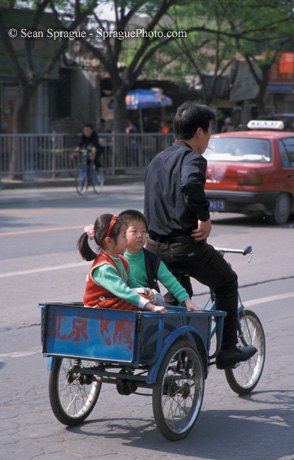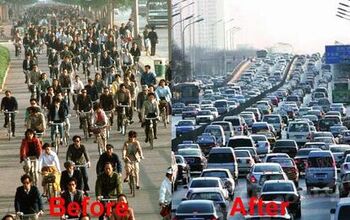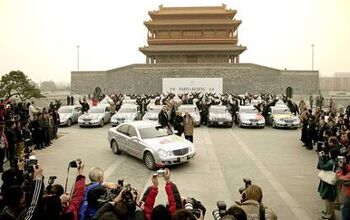The China Syndrome: 50 Million Cars A Year?

Yesterday, we reported that China wants to be a market of 20m cars in 2012. We didn’t predict that, just reporting the news, ma’am.
A hue and cry ensued: “Can’t be!”
Commentator ohsnapback, who’s forte is lawyering, a much more complex field than economics, prognosticated an immediate burst of the Chinese bubble, with a mega tonnage of more than 100 times of our housing bubble. The argument was promptly defused. After all, China doesn’t borrow money. They lend it. Mostly to the U.S.
Then, commentator ra_pro rolled out the really big ordnance: “As I said many times previously: Demography is Chinese destiny as it is Japan’s.” If people would only stop prattling on about demographics, and would check their data first.
Kindly compare age distribution Japan 2020 with age distribution China 2020.
For a real shock, compare age distribution Japan 2050 with age distribution China 2050.
For added spice, factor in that the last Chinese census (it was taken in 2000 and never really finished) is considered as deeply flawed.
Conservative estimates say that around 200m people are living off the books in China, more than the whole population of Japan.
A huge chunk of children have not been reported at all, wrote Daniel M. Goodkind of the U.S. Census Bureau. A correct count of births is the lifeblood of demographic projections. If you miss more than a quarter of the children born in any given year, your projections will be off by 25 percent for generations to come.
Not to worry: If China has something in abundance, then it’s people.
The population bomb turning out as a dud, the sustainability squadron was launched: “There isn’t enough space, water, air or oil to sustain Chinese expansion of 20 million cars per year for a very long time,” quoth ra_pro.
Funny, when Americans bought 17m cars a year, where were the people who said “there isn’t enough space, water, air or oil to sustain expansion of 17 million cars per year for a very long time?” Actually, that number still is a wet dream in Detroit and DC. Our own Ed Niedermeyer pointed out in the New York Times: only if the “salad days of 2000” are bested, the tax payer will ever have a chance to get his or her money back from GM. Dream on.
Now, for the really scary part. There are more than 800 cars per thousand people in the U.S., more cars than people with drivers’ licenses. In China, there are only some 76 cars per thousand in China. In most developed countries, the number is between 500 and 600 per thousand.
“They’ll never get there,” I hear someone say. “The poor farmers will ride bicycles and oxcarts forever.”
Not so fast.
In Poland 20 years ago, a car was something for the powerful party elite. Today (actually, by end of 2008) there are 420 cars per thousand in Poland.
So for when will we grant China the same standard of living (or at least driving) as the people in Poland? Many Chinese would object at this point. I have to go to Poland on occasion – not that I’m looking forward to it – and last time I was there, the mayor of a good sized town complained that they didn’t have the money to light the Christmas tree on central square. The local KTV in any Chinese village is an orgy of neon all year round.
420 cars per thousand, in China that comes out to a total of 550m cars on the road, if the 1.3b population is correct. Or 630m cars, if the more likely 1.5b population is right. Let’s stick with 1.3b pop and 550m cars, in order to avoid even more anxiety.
How many cars do Chinese have to buy to get to the level of Poland in a reasonable amount of time? Let’s ignore popular wisdom that Chinese cars fall apart the minute you drive them off the lot, and let’s assume a really low scrapping rate. To make calculation easy, let’s call it 500m more cars needed.
(Don’t hyperventilate. That’s only twice the number of cars on the road than in the U.S. and the U.S. has only 1/5th or so of the population of China.)
So how much time do we give China to reach the same standard of living (or driving) as Poland in 2008? 10 years? (Many Chinese would loudly object.) That’s 50m cars per year. Yes, 50,000,000.
You think that’s impossible? Ok, then let’s give the Chinese 20 years to catch up with Poland. (Many Chinese would take to the streets at this point, something the Chinese government really would not appreciate.) That’s 25m cars per year.
Still impossible?
Hint 1: Beijing, a city of 17m people, already has 4m cars. 240 cars per thousand. Poland had 265 cars per thousand in 2000. Shanghai has so many cars that the city has to limit growth by auctioning off license plates. People want to drive so badly, that they pay more for a plate in Shanghai than for some new cars. By the way: The population of Beijing and Shanghai, added together, roughly equals the population of Poland.
Hint 2: A gallon of gas of dubious quality costs $4.45 in Beijing. Using the ever so popular purchasing power conversion, it would feel more like $8. (The junior secretary, who gave me the 8 RMB/liter rate, makes $300 a month – I’m no slave driver, it’s the going rate.) And nevertheless, they are buying cars like there is no tomorrow. An unsaturated market does that.
But what about the gasoline? Ecogeek.com, a publication definitely beyond suspicion of promoting worldwide wastage, recently pointed out: “The president of China’s Innovation Center for Energy and Transportation has said that Chinese officials are drafting new mileage standards that would require an 18 percent improvement in fuel economy by 2015. New cars in China already average about 35.8 mpg and under the new rules, would be required to get 42.2 mpg by 2015. The new U.S. standards require an average mgp of 35.5 by 2016.”

Bertel Schmitt comes back to journalism after taking a 35 year break in advertising and marketing. He ran and owned advertising agencies in Duesseldorf, Germany, and New York City. Volkswagen A.G. was Bertel's most important corporate account. Schmitt's advertising and marketing career touched many corners of the industry with a special focus on automotive products and services. Since 2004, he lives in Japan and China with his wife <a href="http://www.tomokoandbertel.com"> Tomoko </a>. Bertel Schmitt is a founding board member of the <a href="http://www.offshoresuperseries.com"> Offshore Super Series </a>, an American offshore powerboat racing organization. He is co-owner of the racing team Typhoon.
More by Bertel Schmitt
Latest Car Reviews
Read moreLatest Product Reviews
Read moreRecent Comments
- Michael S6 Very confusing if the move is permanent or temporary.
- Jrhurren Worked in Detroit 18 years, live 20 minutes away. Ren Cen is a gem, but a very terrible design inside. I’m surprised GM stuck it out as long as they did there.
- Carson D I thought that this was going to be a comparison of BFGoodrich's different truck tires.
- Tassos Jong-iL North Korea is saving pokemon cards and amibos to buy GM in 10 years, we hope.
- Formula m Same as Ford, withholding billions in development because they want to rearrange the furniture.




































Comments
Join the conversation
ohsnapback, in reference to your words about TTAC authors insulting their readers, I for one sure didn't mean to sound arrogant or unfriendly. I'm sorry if I did. Sometimes a spirited discussion gets a little too heated; I've certainly been guilty of that in the past, so thank you for telling me when things are getting out of hand. Please continue to contribute your counterpoints.
ill just say this 2002-2007 everybody was WOOOWing @ dubai. 2007 and later, how did that end?